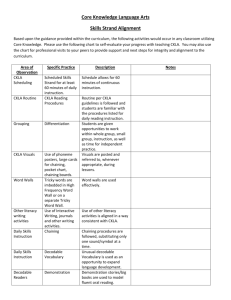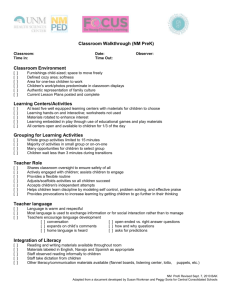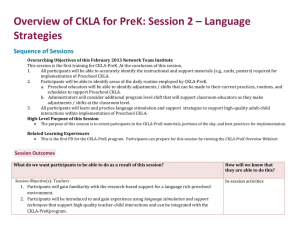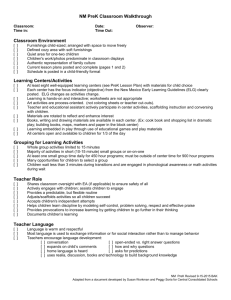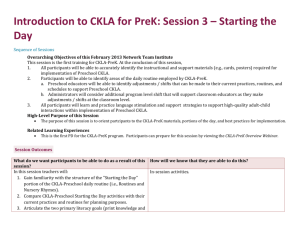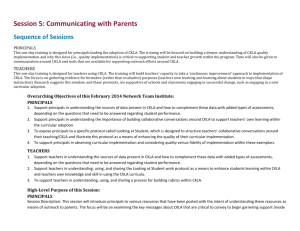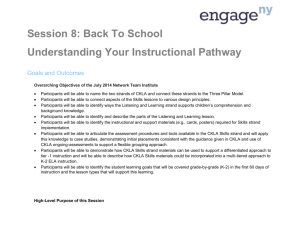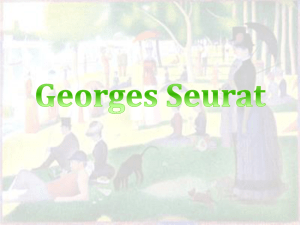Facilitator`s Guide: Small Group Skills FG
advertisement
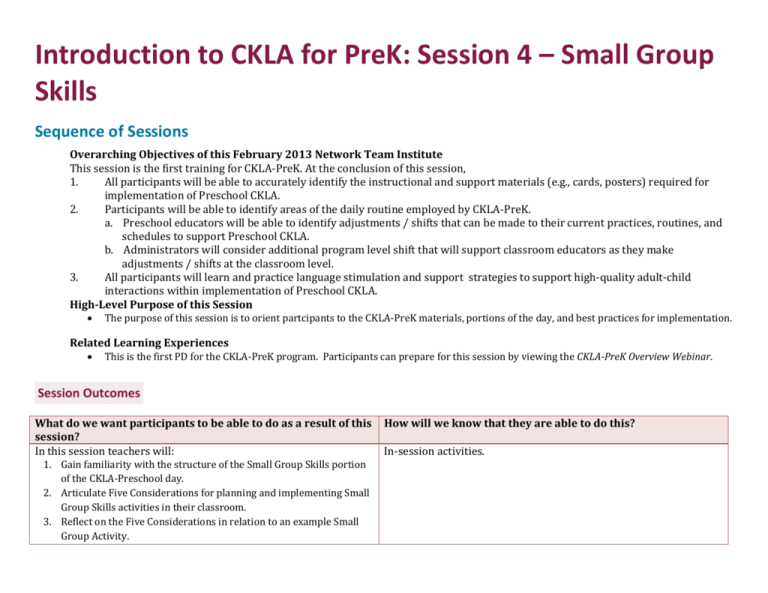
Introduction to CKLA for PreK: Session 4 – Small Group Skills Sequence of Sessions Overarching Objectives of this February 2013 Network Team Institute This session is the first training for CKLA-PreK. At the conclusion of this session, 1. All participants will be able to accurately identify the instructional and support materials (e.g., cards, posters) required for implementation of Preschool CKLA. 2. Participants will be able to identify areas of the daily routine employed by CKLA-PreK. a. Preschool educators will be able to identify adjustments / shifts that can be made to their current practices, routines, and schedules to support Preschool CKLA. b. Administrators will consider additional program level shift that will support classroom educators as they make adjustments / shifts at the classroom level. 3. All participants will learn and practice language stimulation and support strategies to support high-quality adult-child interactions within implementation of Preschool CKLA. High-Level Purpose of this Session The purpose of this session is to orient partcipants to the CKLA-PreK materials, portions of the day, and best practices for implementation. Related Learning Experiences This is the first PD for the CKLA-PreK program. Participants can prepare for this session by viewing the CKLA-PreK Overview Webinar. Session Outcomes What do we want participants to be able to do as a result of this session? In this session teachers will: 1. Gain familiarity with the structure of the Small Group Skills portion of the CKLA-Preschool day. 2. Articulate Five Considerations for planning and implementing Small Group Skills activities in their classroom. 3. Reflect on the Five Considerations in relation to an example Small Group Activity. How will we know that they are able to do this? In-session activities. 4. Understand logistics involved in implementing Small Group Skills and articulate shifts they might need to make in their current routines to accommodate Small Group Skills. 5. Compare CKLA-Preschool Small Group Skills activities and routines with their current practices and routines. Session Overview Section The Structure of Small Group Skills Activities Five Considerations for Small Group Small Group Skills Logistics Time 25 minutes 50 minutes 20 minutes Overview Prepared Resources Participants will gain familiarity with Materials used include: the structure and purpose of the 1. CKLA PreK Small Group Skills Small Group Skills portion of the PPT CKLA-Preschool day. This session will present Five Materials used include: Considerations for planning and 1. CKLA PreK Small Group Skills implementing Small Group Skills PPT activities in their classroom. Teachers 2. CKLA PreK Small Group Skills will view two demonstration HO (Handwriting Strokes) activities and reflect on the Five Considerations in relation to the second example Small Group Activity. Participants will consider logistics Materials used include: 1. CKLA PreK Small Group Skills involved in implementing Small Group Skills and articulate shifts PPT they might need to make in their current routines to accommodate Small Group Skills. Materials used include: Small Group Implementation Reflection 40 minutes Compare CKLA-Preschool Small 1. CKLA PreK Small Group Skills Group Skills activities and routines PPT with their current practices and 2. CKLA PreK Small Group Skills routines. HO (Strategies for Adaptation) Facilitator Preparation Session Roadmap Section 1: The Structure of Small Group Skills Activities Time: [minutes] In this section, you will… Materials used include: 1. Gain familiarity with the structure of the Small Group Skills portion of the CKLA-Preschool day. Time Slide #/ Pic of Slide 1. CKLA PreK Small Group Skills PPT Script/ Activity directions Key Points: • Set nine baskets on the stage. • Call for eight volunteer “players” and one volunteer “coach.” • Give each player a few balls and have them turn so that their backs face the baskets. • At the same time, they should try to get the balls into the baskets without looking. • Have the coach try to give feedback to all nine players as they simultaneously toss balls into the basket. Key Points: • Remove seven baskets from the stage. • Have all but two players sit down. The coach remains on the stage • Give each player a few balls and have them turn so that their backs face the baskets. • At the same time, they should try to get the balls into the baskets without looking. • Have the coach try to give feedback to both players as they simultaneously toss balls into the basket. GROUP Key Points: 1. Round 1 is analogous to whole-group instruction where one teacher is giving feedback to a group of students. 2. During whole-group instruction, it is more challenging to individualize feedback to each student’s needs. 3. Round 2 is analogous to small-group instruction where one teacher is giving feedback to fewer students. 4. During small-group instruction, it is possible to individualize feedback to each student’s needs. Key Points: 1. Small Group activities are found in the Teacher Guide after the Starting the Day activities. 2. There are two Small Group activities each day. Key Points: 1. This is video shows a teacher conducting a Small Group. 2. The students are in the All About Me domain and they are learning parts of their bodies, including the parts of the face. 3. In this activity, the students are drawing self-portraits and labeling with their names, which are printed on slips of paper. 4. Notice how the teacher actively facilitates by prompting students to name the parts of the face that they will add to their drawings. 5. The second part of the clip shows the part of the activity where students recognize their pre-printed names and glue them to their self portraits. While students find and glue their names, the teacher also takes dictation from students as to why they are special, which is content from the All About Me domain Key Points: 1. The purpose is to introduce new skills and provide opportunities for individualization and differentiation. 2. Maximum of ten kids with one adult 3. Activities take approximately ten minutes each. 4. If done simultaneously, this amounts to twenty minutes of small group instructional time per day. 5. Teachers schedule small groups to work for their particular classroom schedule and composition. Key Points: 1. The goal of the slide is to show the general lay-out of the small group activities, not to read the words. 2. There are two small group activities per day. 3. Each group begins with an active warm-up before the main activity. Warm-ups are an opportunity to practice previously-learned skills. 4. Skill-building activities are designed to introduce new skills such as rhyming, handwriting strokes, identifying initial sounds, etc. 5. Small group activities provide opportunities to differentiate instruction. Often, suggestions for differentiation are given (such as rounds of play). Section 2: Five Considerations for Small Group Time: 45 minutes [45 minutes] In this section, you will… Materials used include: 1. CKLA PreK Small Group Skills PPT 1. Articulate Five Considerations for planning and implementing 2. CKLA PreK Small Group Skills HO (Handwriting Strokes) Small Group Skills activities in their classroom. 2. Reflect on the Five Considerations in relation to an example Small Group Activity. Time Slide #/ Pic of Slide Script/ Activity directions Key Points: 1. We are going to consider five principles of preparation for conducting Small Group. 2. First, I will do an example Small Group activity. 3. We will go through each consideration one at a time. We will talk about what they mean and how they apply to the example activity. 4. Then, participants will see a second example activity. They will have a chance to reflect on the five considerations as they apply to the second example activity. GROUP Key Points: 1. This activity occurs early in the year and teaches word awareness as well as the vocabulary words ‘same/different.’ It follows activities related to environmental noises that are students’ first exposure to listening to noises. 2. Students will build on this concept of words and their knowledge of same/different as they start to identify individual sounds later in the school year. Key Points: 1. Provides an active task before the more calm task to follow 2. Has a content connection in that students are learning the names body parts, including the face 3. Gestures give all students a way to participate. Key Points: Words: Same or Different? Students will say whether two words are the same or different. 1. Explain to students that they are going to play a listening game. You want them to listen to hear if two words are the same or different. Remind students of the game they played with the Mystery Sound Box where they had to say whether a noise was the same or different. You are going to do the same thing, but with words. 2. As you say the first word, hold up one finger. As you say the second word, hold up a second finger. 3. First, demonstrate each pair. Say, “Open [pause] open. Those words were the same. They were both the word ‘open’.” 4. Then say, “Open [pause] shut. Those words were different. They were not the same. One word was ‘open’ and the other word was ‘shut’.” 5. Tell the students, “I want you to listen to the words I say and tell me if I say the same word or different words. Listen carefully, so you don’t get tricked!” 6. Continue playing the game using the following word pairs: Clap/clap Clap/chin Mouth/creep Creep/creep Creep/chin Open/open Open/Shut Shut/Shut Cheeks/eyes Eyes/Eyes Smiling/Peeking Peeking/Peeking Key Points: 1. There are two preparation points: 2. Before beginning the domain, gather or replenish required materials that you may not have at the ready 3. Before beginning the activity, prepare materials and make sure they are easily accessible. Modify any materials that may need to be adapted to the needs of your students or resources of your school 4. For the example activity, I would have needed to locate the Nursery Rhyme Poster and place it close to where I was going to conduct Small Group. Key Points: 1. Small Groups can be held in a variety of settings. 2. When previewing the activity, consider where in the classroom it makes the most sense to conduct the activity. 3. Provide freedom of movement for young children by allowing them to stand or sit on the floor when practical. Consider “stability before mobility,” meaning students should anchor their bodies on the floor or in a chair when fine motor skills are required. Key Points: 1. Review means to read and understand the activity and its relationship to the Language Arts and Core Content Objectives before beginning instruction. When reviewing, consider who will conduct each activity and how to arrange the gathered materials. 2. Rehearse means to practice by reading aloud the instructions in the activity or pretending to teach the activity. Often, new teaching techniques are introduced in the body of the activity, and these benefit from prior practice. Sometimes, specific wording is called for and practicing beforehand helps smooth the delivery of this language of instruction when working with students. Key Points: 1. Small Groups provide opportunities for differentiation, or adjusting instruction and materials to the needs of the students. 2. Sometimes, suggestions for differentiation are given (as ‘rounds’ or ‘teaching tips’). 3. Other times, teachers choose to adapt suggested materials to the needs of their students (e.g., an activity to address fine motor skills calls for making bracelets from cut drinking straws, and the teacher decides to use large wooden beads for one group). Key Points: 1. Small Group skills can be reinforced throughout the school day, particularly in Learning Centers. 2. Sometimes, extending the activity is as simple as placing the materials in a particular center once students have learned how to interact with them. 3. Teachers might place materials they already own that are related to Small Group activities in centers (e.g. a human body puzzle in the Games Center after students have learned the parts of the body, books on the five senses in the library center, materials with different textures in the sensory bin). 4. Other times, teachers might adapt small group materials to centers by creating a folder game, making an interactive bulletin board, laminating Activity Pages so that they can be used again, etc. 1. 2. 3. 4. 5. Be sure participants have copies of Small Group Activities Handouts for Participants. Key Points: Example Activity 2 is an example of the way handwriting strokes are taught during the first half of the year. Handwriting strokes are marks or shapes that are used to form letters and they are taught before students are asked to write letters. During these activities, students learn crayon control and practice grip. Each student has his/her own My First Strokes book that serves as a record of strokes learned and provides for repeated practice. Students practice all strokes learned up until that point as part of Warm Ups. What follows is a modified version of this activity, since participants do not have My First Strokes Books. We are going to learn vertical and horizontal lines…other strokes include diagonal lines, X, cross, moon, zigzag, dot, circle, etc. Key Points: 1. Provides an active task before the more quiet task to follow. 2. So, participants need to stand up. 3. Allows for gross motor movement before fine motor movement required for handwriting. Key Points: 1. Moves students from a gross motor activity to a fine motor activity (but doesn’t require pencil control). 2. Opportunity for students to quickly rehearse writing strokes they have learned. My First Strokes Book Students will practice two handwriting strokes by tracing lines with their fingers on their Activity 2 Handouts (My Horse and The Fence, dark lines). 1. Have each student find their Activity 2 Handouts (My Horse and The Fence, dark lines). 2. Ask students to hold up their pointer fingers when they are ready to trace. 3. Read the poem for each stroke. Have students trace the lines with their pointer fingers as you read each verse. Key Points: 1. Students have an opportunity to trace the lines they have just learned. 2. Students will then complete the same activity page within the grey lines—they will draw the lines themselves. Writing with Primary Crayons Students will practice writing horizontal and vertical lines using primary crayons. 1. Have each student find their Activity 2 Handouts (My Horse and The Fence, grey lines). 2. Give each student a primary crayon. 3. Have students practice their vertical and horizontal writing strokes by drawing lines on the Activity Pages starting at the triangle and ending at the dot. 4. Encourage students to reference their Activity 2 Handouts (My Horse and The Fence, dark lines) if they cannot remember a specific stroke. 5. If students finish both strokes, have them color the background of their Activity Page or practice drawing horizontal and vertical strokes on a blank piece of paper. Key Points: 1. Remember the warm-ups: the poem for gross motor movements and the tracing of the black lines with fingers. 2. Remember the activity- tracing the grey lines with primary crayons. 3. Reflect on the Five Considerations for Small Group that we discussed earlier. 4. Record your reflections on the chart paper. Have each table share 1-2 elements of their chart. Post charts for gallery walk at the next break. Section 4: Small Group Skills Logistics Time: 20 minutes [20 minutes] In this section, you will… Materials used include: 1. Understand logistics involved in implementing Small Group Skills and articulate shifts they might need to make in their current routines to accommodate Small Group Skills. Time Slide #/ Pic of Slide 1. CKLA PreK Small Group Skills PPT Script/ Activity directions Key Points: 1. Figuring out the logistics of conducting Small Groups in your particular classroom is the “elephant in the room.” 2. Some classroom schedules may already accommodate small groups, other may have to make shifts in their schedules in order to do so. 3. If planning a full adoption of CKLA-Preschool, the daily schedule will need to accommodate two ten-minute small groups dedicated to Language Arts instruction. 4. If planning to adapt CKLA-Preschool, then there may be some flexibility in how small groups are conducted. 5. We will discuss some considerations and best practices for scheduling Small Groups, then provide teachers time to consider how they might integrate small groups into their daily schedules. GROUP Shutterstock Image # 101086585 Key Points: 1. Generally, small groups are conducted in the morning when everyone is fresh. 2. Keep in mind cycles of active and calm activities so that students are more likely to be able to concentrate. 3. Each classroom will differ in how they choose to schedule Small Groups, depending on the constraints that are particular to their school. 4. Sample schedules show one way Small Groups might be incorporated into the preschool day. Key Points: 1. There are a variety of adults who might lead Small Groups: teachers, aides, special educators, classroom volunteers. 2. The teacher may decide to reduce group size by adding a third group where students work independently. Keep in mind that students will not be able to do most CKLA-Preschool activities independently, and the teacher would be responsible for planning this third group. 3. The teacher and aide might each lead one small group, which would require a total of twenty minutes for all students to complete both Small Groups. 4. The teacher might choose to lead both Small Groups herself, which would require a total of forty minutes for all students to complete both Small Groups. Key Points: 1. Variation 1: The teacher and assistant each take a group and work on different activities that meet the needs of the students assigned to each group. 2. Using this method, it would take 20 minutes for all students to complete both CKLAPreschool Small Group activities. 3. Variation 2: One adult pulls a few students to work in Small Group. The other students participate in a medium-group activity. 4. Using this method, it may take 40 minutes for all students to complete both CKLAPreschool Small Group activities. 5. Advantages: In all activities planned by CKLA-Preschool, the teacher can work with all students if she chooses. Variation 2 allows for smaller group size. Variation 1 is timeefficient. 6. Disadvantages: Students must be able to move efficiently between groups. Variation 2 is time-intensive, it may be difficult to plan a medium-group activity that lasts for 40 minutes. Key Points: 1. The teacher and the classroom aide each conduct a small group while one independent activity is taking place. 2. The teacher plans the “independent group” activity. CKLA-Preschool does not provide these activities. 3. Using this method, it would take 30 minutes for all students to complete both CKLAPreschool Small Group activities. 4. Advantages: Smaller group size than Split Group Variation 1. It is time efficient (30 minutes). Students learn to work independently. 5. Disadvantages: Students must be able to work independently. Additional planning time is required for independent group activity. Additional transition time is required. Key Points: 1. The teacher conducts a small group activity for the first 10 or 15 minutes of center time. 2. While the small group session is being conducted, the teacher assistant rotates among the centers engaging in conversation and positive teacher-child interactions. 3. When the small group is finished, the teacher and children join centers already in progress. The teacher joins the teacher assistant in rotating among the centers to engage in conversation and positive teacher child interactions. 4. Using this method, it would take 40 minutes for all students to complete both CKLAPreschool Small Group activities. 5. CAVEAT: Full adoption of CKLA-Preschool also calls for an adult to facilitate a content-related activity during Learning Centers, so an extra adult may be required during Center Time in order to implement the Teacher Table model. 6. Advantages: Smaller group size, teacher works with every student. 7. Disadvantages: Students may be distracted by others. It takes at least 40 minutes for every student to get to both Small Group activities. Section: Small Group Implementation Reflection Time: 10 minutes [10 minutes] In this section, you will… Materials used include: 1. Compare CKLA-Preschool Small Group Skills activities and routines with their current practices and routines. 1. CKLA PreK Small Group Skills PPT 2. CKLA PreK Small Group Skills HO (Strategies for Adaptation) Distribute Small Groups Strategies for Adaptation Handouts for Participants to each participant. Key Points: 1. Full adoption requires two ten-minute Small Groups every day. 2. We recognize that classroom and curricular demands may make setting this time aside quite challenging. 3. Each teacher will have to customize his/her classroom schedule to incorporate Small Groups. 4. Now is time for reflection on how Small Groups might play out in your classrooms. 5. Administrators approach this reflection from a program level – what resources (materials and human) might be needed to best support small group instruction? How can administration assist in minimizing constraints? 6. We offer a list of possible strategies for adapting CKLA-Preschool to a variety of classroom schedules when two ten-minute groups are not possible every day. For reference only: • Carefully consider the Core Content and Language Arts Objectives in conjunction with your own students’ background knowledge and skills. Then, examine planned activities to identify those that you might consolidate, while still providing enough instructional time to meet objectives. • Conduct three small groups at once (to include math or other subject areas) when additional adults (e.g., special educators, parents, paraprofessionals, etc.) are present in the classroom. • If the activity permits it (e.g., easel painting, playing a familiar game, etc.) and students are ready, allow students to complete Small Group activities with intermittent supervision (i.e., you facilitate two group at once). • Make familiar materials from Small Group available during Center time to reinforce Small Group learning. • Conduct writing strokes and fine-motor activities during Center time, placing related materials in the Writing or Art center. • When necessary, conduct one Small Group per day, adding books from the Supplemental Trade Books list as read-alouds when needed. Use this strategy intermittently and combination with others listed below (such as consolidating activities or conducting Extension outside; see below) to ensure students still receive needed instruction. • Conduct Small Groups on Pausing Point and Assessment days • Adapt Small Group or Extension Activities so they might be completed outside and give students the option of completing them during outside time • Omitting Small Group activities if students have mastered particular skills (e.g., handwriting, name writing, reciting rhymes) Use the following icons in the script to indicate different learning modes. Video Reflect on a prompt Turnkey Materials Provided See materials section. Additional Suggested Resources Active learning Turn and talk
